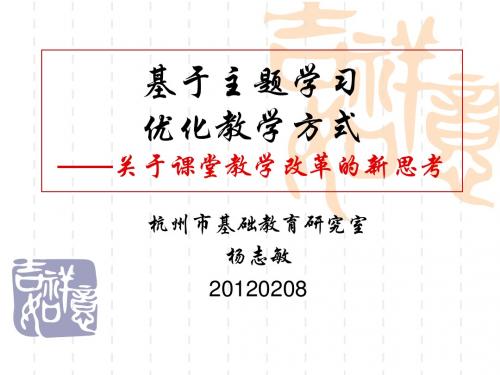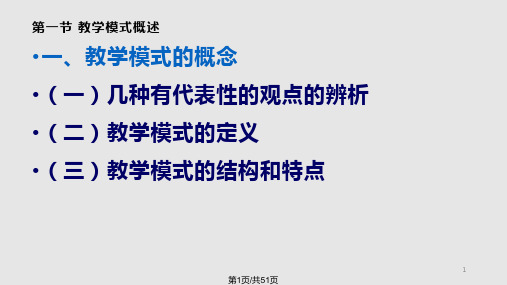优化教学方式.ppt
基于主题学习优化教学方式

4.组织高一、高二、高三教学质量检测及中考命题。 5.参与专题论文评比,选拔优秀论文参加省高中教学 论文评比。
生活主题整合——用精心选择的生活主题覆盖 生活主题整合
教学目标,通过生活片段的渐次展开和相关问题 的逐步解决引导学生在生活现象中“发现”主题、 提炼观点、提升能力,促发情感。
操作实践
以《国家财政》为例:
(一)研究学情、确定课堂方向 研究学情、
教材:观点概念多——急需整合 学生:距离生活远——急需拉近 重点:财政的作用、影响财政的因素 难点:财政作用二:促进国民经济平稳运行 现实热点:如何看待国家财政连年高增长?
基于“主题学习”的高效课堂构 想
思路: 设计学习目标——分解学习任务 设计学习过程——掌握基本观点 设计分享环节——交流学习结果 设计检测环节——评价学习成果
基于“主题学习”的高效政治课堂模板示意 图 非典型主题学习
特 点
学习主线贯穿——运用现代学习理念,把课堂 学习主线贯穿
设计成“激学——自学——互学——导学——综 合探究学习”等渐次推进并由多种学习方式叠加 的学习过程,让学生在课堂中学会知识、学出能 力、学出素养。
课堂现实
满堂灌——课堂以接受学习为主 满堂加——缺乏有效的教学取舍 满堂问——缺乏有效的学习设计 满堂赶——缺乏有效的学习时空 ------
改革课堂教学刻不容缓
关于主题学习
“主题”是指依据生活逻辑理念整合的生活 主题” 主题 话题。主题一般围绕一个现实生活话题, 话题。主题一般围绕一个现实生活话题, 以生活逻辑为主线精选几个生活片段构成, 以生活逻辑为主线精选几个生活片段构成, 具有相对闭合的特点。 具有相对闭合的特点。 “主题学习”是指课堂教学过程中围绕预 设的生活主题进行自主、合作、探究等多 种形式的学习与交流。
构建高效课堂ppt课件

感谢您的观看
汇报人:
及时反馈和评价学生表现
及时反馈:在课堂教学过程中,对 学生回答问题、完成作业等表现给 予及时反馈和评价,帮助学生了解 自己的学习状况。
鼓励和激励:对学生的表现给予积 极的鼓励和激励,增强学生的学习 动力和自信心。
添加标题
添加标题
添加标题
添加标题
评价标准:制定明确的评价标准, 包括学习态度、课堂参与度、任务 完成情况等方面,确保评价的全面 性和客观性。
构建高效课堂的要素
第二章
教学目标明确
明确的教学目标有 助于提高课堂效率
设定明确的教学目 标有助于学生更好 地掌握知识
教学目标应该与教 学内容紧密结合
教学目标应该具有 可衡量性,以便于 评估教学效果
教学内容精准
教学目标明确
内容选择恰当
教学方法适合
评价标准明确
教学手段多样
运用多媒体教学 组织小组讨论 教师指导与启发相结合 运用多种教学方法,激发学生兴趣
第一章
提高教学质量
高效课堂能够激发 学生的学习兴趣和 动力,提高学习效 果。
高效课堂能够提高 教师的教育教学水 平,促进教师专业 发展。
高效课堂能够优化 教学流程和教学资 源,提高教学效率 。
高效课堂能够促进 师生互动和交流, 增进师生感情。
激发学生的学习兴趣
提升学生的学习积极性和主动 性
增强学生的学习自信心和成就 感
教育技术的不断进步
人工智能在教育中 的应用
虚拟现实技术的教 育应用
大数据支持下的个 性化教育
远程教育和在线学 习的普及化
教师队伍的不断优化
教师素质将不断提 高
教师将更加专业化
教师将更加职业化
数学作业优化方案PPT

数学作业优化方案PPT引言数学是一门需要大量练习和理解的学科,而数学作业往往是学生们掌握和巩固知识的重要途径。
然而,传统的数学作业方式存在诸多问题,如效率低、乏味枯燥等。
为了提高数学学习的效果和学生的兴趣,我们需要寻找一种优化方案来改进数学作业的方式。
问题分析效率低传统的数学作业方式往往需要学生花费大量时间来完成,尤其是在繁杂的计算和证明题上。
这不仅浪费了学生宝贵的学习时间,还可能导致学习效果不理想。
缺乏趣味性传统的数学作业往往缺乏趣味性,让学生感到单调乏味。
这容易导致学生对数学产生厌倦情绪,从而影响其学习积极性和兴趣。
优化方案引入技术手段借助现代技术手段,可以在一定程度上提高数学作业的效率和趣味性。
以下是几种可能的技术手段:1.使用数学软件:数学软件可以帮助学生快速进行繁杂的计算,节省时间和精力。
同时,数学软件还可以通过可视化和动画效果,增加作业的趣味性和可理解性。
2.利用在线学习平台:在线学习平台可以提供大量的数学题目和习题,帮助学生巩固和扩展知识。
通过在线学习平台,学生可以根据自己的学习进度选择适合的题目,提高学习效率和兴趣。
设计互动性题目为了增加数学作业的趣味性,可以设计一些具有互动性的题目。
这些题目可以结合实际场景,让学生在解决问题的过程中体会到数学的应用和乐趣。
例如,可以设计一道关于购物打折的题目,让学生计算最优的购买方案;或者设计一道关于图形变换的题目,让学生通过互动操作进行图形变换并观察结果。
定期反馈和评估定期反馈和评估是优化数学作业的重要环节。
通过及时了解学生的学习情况和困惑,可以及时调整作业内容和方式。
同时,及时给予学生积极的评价和建议,可以激发他们学习的动力和兴趣。
实施方案为了有效实施数学作业优化方案,可以采取以下步骤:1.培训教师:为了让教师能够熟练运用数学软件和在线学习平台,可以组织相关培训课程,提高教师的技术水平和教学能力。
2.设计互动性题目:教师可以根据学生的兴趣和年级特点,设计一些具有互动性的题目,丰富数学作业内容。
改善提高课堂教学质量的影响因素及方法PPT课件

引入问题或案例,激发 学生兴趣
引导学生自主思考,提 出问题
通过讨论、互动,引导 学生深入理解知识点
鼓励学生发表见解,培 养批判性思维
小组合作促进交流分享经验
01
02
03
04
分组合作,明确任务和目标
小组成员互相交流,分享经验 和观点
小组展示成果,进行评价和反 馈
培养学生团队协作和沟通能力
案例分析培养解决问题能力
选取典型案例,进行深入剖析
引导学生分析问题,提出解决方案
组织学生进行角色扮演,模拟解决问题
培养学生分析问题和解决问题的能力
06
评价体系完善及持续改进策略
多元化评价方式构建
引入多种评价方式
除了传统的笔试、口试等评价方式,还可以引入表现性评价、过程 性评价、差异化评价等,全面、客观地评价学生的学习情况。
以学生为中心
关注学生的全面发展,注重学生 的个性差异和多元化需求,提高
教学的针对性和实效性。
强调素质教育
注重培养学生的创新精神和实践能 力,提高学生的综合素质和社会适 应能力。
倡导终身学习
引导学生树立终身学习的理念,培 养学生的自主学习能力和终身发展 的意识。
教师团队协作与沟通能力提升
加强团队建设
及时有效的反馈
针对学生的学习表现,给予及时、具体、有针对性的反馈,帮助 学生调整学习策略。
鼓励与激励机制
通过设立奖励机制、开展竞赛等方式,激发学生的学习动力和自 信心。
04
课程内容优化与资源整合方案
精选优质教材和辅助资源
筛选符合课程目标和学生需求的教材 ,确保内容的科学性、系统性和适用 性。
关注教材和资源的更新与迭代,及时 引入最新的教学成果和行业动态。
pbl教学法ppt幻灯片

06
PBL教学法实施效果评价及改进方向
过程性评价:关注活动过程中学生表现
观察学生在小组讨论中的表现
是否积极参与讨论,提出有建设性的观点和建议。
记录学生在解决问题过程中的表现
是否能够独立思考,运用所学知识解决问题。
评估学生的团队协作能力
制定科学合理的评价标准,对学生的成果进行全面客观的评价。
针对学生的表现和成果给予具体的建议和指导,帮助他们了解自己的不足和需要改 进的地方。
鼓励学生进行自我评价和互评,促进他们反思自己的学习和探究过程,提高自我认 知和自我管理能力。
05
学生在PBL中的成长与收获
知识技能提升
深入理解学科知识
通过PBL项目,学生能够将所学理论知识应用于实际问题中,加深 对学科知识的理解和掌握。
评估解决方案
学生需要对提出的解决方案进行评估和比较,从而选择最优方案, 锻炼批判性思维。
自主学习能力增强
1 2
主动寻求资源
在PBL项目中,学生需要主动寻找相关资源和信 息,以支持项目的进行和问题的解决。
自我驱动学习
学生能够在项目过程中发现自身不足并主动学习 相关知识和技能,实现自我驱动学习。
3
持续改进自我
鼓励学生之间的合作和交流, 促进小组内部的互动和分享。
监督者角色:关注进度,确保质量
定期检查和评估学生的学习进度和成 果,确保他们按照计划进行探究活动 。
对学生的表现和成果给予及时的反馈 和建议,帮助他们不断改进和提高。
及时发现和解决学生在探究过程中遇 到的问题和困难,保证活动的顺利进 行。
评价者角色:给予反馈,指导改进
最优化方法全套教学课件

b1
,
an
b2
。
bn
向量也常用希腊字母 , , , ,, 等表示。
向量内积的性质:
ⅰ) , ,(对称性);
ⅱ) , , , k, k , (线性性);
ⅲ) , 0 ,当且仅当 0 时,, 0(正定性);
向量的长 ,
这个公式与一元函数展开到两项的Taylor公式是相对的。
梯度的性质:当梯度 f x 连续时,
第一,若 f x 0 ,则 f x 必垂直于 f x 过点
x 处的等值面;
第二,梯度方向是函数具有最大变化率的方向。
下面以 f x1, x2 x12 x22 1 为例来解释这个性质。
上图是该函数的等值线图。
的异同。
p
x1 x2
xn
根据极限理论,易见
若
f x0
p
0,则p方向是 f
x
在点
x0 处的上升方向;
若 f x0 0,则 p方向是 f x在点 p
x0
处的下降方向。
因此,方向导数的正负决定了函数值的升降。
定理1.2
设 f : Rn R1 在点 x0 处可微,则
f x0
p
f
x0
T
e
其中 e 是非零向量 p 方向上的单位,向量。
f x0
p
f
x0
e
cos
f
x0 , p
f x0
p
f
x0
cos
f
x0 , p
f x0
据此有
ⅰ) 等号成立当且仅当 p 与f x0 同方向或与 f x0
同方向。且当
p与
小学教育ppt课件教案,迭代思维:通过不断试错和修正来解决数学问题的方法

迭代思维在解决数学问题中具有广泛 应用,如代数、几何和概率统计等领 域。
迭代思维的重要性
提高解决问题的能力
增强数学应用能力
通过不断试错和修正,可以帮助学生 更好地理解问题,提高解决问题的能 力。
通过解决实际问题,学生可以更好地 将数学应用于实际生活中,增强数学 应用能力。
培养创新思维
小学教育ppt课件教案,迭 代思维通过不断试错和修正 来解决数学问题的方法
目录
CONTENTS
• 引言 • 迭代思维的定义和原理 • 如何应用迭代思维解决数学问题 • 数学问题中的迭代思维实例 • 培养小学生的迭代思维 • 总结与展望
01 引言
主题介绍
迭代思维
一种通过不断试错和修正来解决问题 的思维方式。
详细描述
在数列问题中,迭代思维常用于找出数列的通项公式或规律。例如,在求解等差数列或等比数列时, 可以通过不断推导和归纳,找出数列的通项公式或规律。这种方法需要严密的逻辑推理和数学运算能 力,因为每次迭代都可能产生新的公式和表达式。
05 培养小学生的迭代思维
通过游戏培养小学生的迭代思维
游戏设计
利用游戏的方式,让学生在玩乐中体验迭代思维的过程。例如,设计一个解谜 游戏,通过不断尝试和修正答案,最终找到正确的解。
教师需要不断更新教学理念和方法,结合新技术手段,提高教学效果和学生的学习体验。
在教学过程中,应注重培养学生的创新思维和实践能力,为未来的学习和工作打下坚实的基 础。
感谢您的观看
THANKS
迭代思维是一种重要的数学思维方式,通过不断试错和修正,可以帮助学生更好地 理解和掌握数学问题。
在教学过程中,教师需要注重培养学生的自主学习和探究能力,引导学生主动思考 和解决问题。
教育学--教学方法和教学组织形式 ppt课件

(2)谈话法 也叫问答法,是教师按一定的教学要求向学生提出问题,要求
学生回答,并通过问答的形式来引导学生获取或巩固知识的方
法。 谈话法的基本要求: ①要做好提问准备。②善于启发诱导。③做好归纳、小结。
(3)讨论法 在教师的指导下,学生以全班或小组为单位,围绕教材的中心
问题,各抒己见,通过讨论或辩论活动,获得知识或巩固知识
17.“头脑不是一个可以填满的容器,而是一支需要被点燃的火
把”,这句话体现了( 的教学方法思想。 )
18.“产婆术”属于(
)教学原则。
三、选择题
1.教学工作的中心环节是( A.备课 C .课外辅导 A.讲授法 B.谈话法 B.上课 D.学业成绩的检查与评定 )。 C.讨论法 )。 B.重要组织形式 D.辅助形式 )。 D.1949年 C.1935年 D.讲读法 )。 2.由教师提出问题,激发学生思考,通过双边活动而获取知识的方法叫( 3.课堂教学是教学的( A.唯一组织形式 C.基本组织形式 A .1962年 B.1903年
进,从而增加信息来源或教育影响源。
⑥班集体内的群体活动和交往有利于学生形成互助友爱、公平竞争的态度和集体主义精 神,并有利于学生形成其他一些健康的个性品质。
班级授课制的缺点:
①教学活动多由教师做主,学生学习的主动性和独立性受到一定程度的限制。
②学生的学习主要是接受性学习,不利于培养学生的探索精神、创造能力和实践 能力。 ③时间、内容和进程都程序化固定化,难以在教学活动中容纳更多的内容和方法 ④由于以“课”为活动单元,而“课”又有时间限制,因而往往将某些完整的教 材内容人为地割裂以适应“课”的要求。 ⑤教学面向全班学生,步调统一,难以照顾学生的个别差异,不利于因材施教。
过程的构成要素。
课堂管理ppt课件(图文)全

教师通过发展和完善课堂内部结构及其积极的引导作用,能极大地 帮助学生对课堂发生的事件和行为予以恰当的解释;并给予更深刻 的自我反省,形成其责任与自律,实现课堂的自组织
课堂管理的原则
内在性原则:课堂管理过程常常比较 重视教师外在管理的作用,而对学生 的内在管理容易忽略。课堂管理要为 学生的主动性和积极性的发挥规定目 标,提供条件,激发和引导其内在动 机,实现学生的内在控制,这是现代 条件下课堂管理的一个根本性变革。
课堂管理的技巧
及时终止问题行为:
学生的问题行为,大多以轻度为主,因而大部分问题行为只需教师运用一定的影响方法便可得到制止。通常采用的影响 方式包括:信号暗示,使用幽默,创设情境,有意忽视,转移注意,移除媒介,正面批评,劝其暂离课堂,利用惩罚
行为矫正,有效转变问题行为:
课堂问题行为矫正的原则课堂问题行为矫正是一个复杂的过程, 需要做深入细致的工作。在整个过程中应遵循特定的原则。奖 励多于惩罚原则,坚持一般性原则,与心理辅导相结合原则
激励原则
有利教学顺利进行的民主氛围, 激励原则还要求教师在课堂管理 中发扬教学民主,鼓励学生主动 发问、质询和讨论,让学生思维
流程中的浪花不断跳跃激荡
课堂管理的原则
反馈原则:
运用信息反馈原理,对课堂管理进行 主动而自觉的调节和修正,是反馈原 则的基本思想。这既要求教师在教学 工作的起始环节——备课过程中,还 要求教师在课堂教学的过程中,不断 运用即时信息来调整管理活动。
C 可行性。不适当规则会因学生无法遵循而形同虚设,使学生产生“有些规则可以不遵循”的心理。
课堂管理的技巧
课堂规则制定的过程要有学生参与
课堂规则的制定应与学生讨论共同制定,以增加学生对规则的认同感,确保规则得到很好的执行。
课程与教学论——教学模式PPT课件

性。(5))效益性。
5
第5页/共51页
二、教学模式的价值和意义
• 教学模式具有较高的理论意义,它以联系的整体的眼光来看待教学过程中的各种要素,这是一种新的思维 方式。
13
第13页/共51页
(三)杜威的教学模式
• 美国著名教育家杜威是进步主义教育流派的代表人 物。杜威以“儿童中心”和“做中学”为基础构建 了他的实用主义教学模式。特点:
• 在教学目标上,强调教学的首要任务在于培养灵敏、 缜密而透彻的思维习惯,使学生养成创造的智慧, 即使人具有创造性的思维能力。
• 在教学程序上,强调完整的教学过程需要经历五个
10
第10页/共51页
• (三)苏格拉底 • 苏格拉底是古希腊著名的哲学家和教育家,他创造了一种以对话为主的教学实践形态,
一般称之为“产婆术”。特点:在教学目标上,认为教学的主要目标不是把现成的知识 传授给学生,而是通过提问、争辩等方式帮助学生探求什么是接受正确知识的过程。在 教学程序上,主要注重以下步骤:一是苏格拉底讽刺,二是定义,三是助产。他认为教 师的角色和作用就是“知识的产婆”,因而后人把他的教育实际形态称作“产婆术”。
3
第3页/共51页
(二)教学模式的定义
•教学模式是在一定教学理论的指导 下,通过相关理论的演绎或对教学 经验的概括和总结所形成的一种指 向特定教学目标的比较稳定的基本 教学范型。即有相对稳定的教学结 构。
4
第4页/共51页
(三)教学模式的结构和特点
• 1教学模式的结构 • 包括以下基本构成要素(1)理论基础。(2)教学目标(教学模式的核心要素)。
有效课堂教学策略与方法PPT课件

四、有效教学的策略
(一)教学策略: 是指在一定的教学思想的指导 下或在一定的教学实践经验的基础上,为有效 的达成一定的教学目标而对教学活动的操作程 序、方法手段、技术等方面做出的概括性规定。 简单的说,就是为实现某一目标而进行的策划 和谋略。教学策略主要包括对教学过程、教学 内容、教学方式、教学媒体、教学组织形式的 策划和选择。教学目标解决的是“教什么”、 “学什么”的问题,那么教学策略要解决的是 “如何教”和“如何学”的问题。
第2页/共60页
(二)在我国有效教学的提出: • 1、针对低效教学、无效教学、负效教学的客观现状。
“教师很辛苦,学生很痛苦” 2、课程改革:课程改革的客观要求 初衷是改变“低效教学”, 发展成倡导“有效教学”。 “有效教学”是寻求教学效益的活动。
第3页/共60页
(三)有效教学的含义
传统的教学观认为,所谓“课堂教学”就是 精通知识的教师向未成熟的学生传递知识的过程。 教学的成败取决于教师的知识能力水平、教学方 法和学生的个人能力。因此,一堂课效果如何, 只看教师教的怎样。
策略、先放后收策略、少改多就策略 • 营造课堂教学的民主氛围的策略
第24页/共60页
五、有效教学的途径与方法
(一)有效的讲解 (二)有效的互动 (三)有效的合作 (四)有效的讨论 (五)有效的问题 (六)有效的迁移
(七)有效的媒体 (八)有效的教学思路
第25页/共60页
• (一)有效讲解 • 教师什么情况下要讲解? • 怎么讲解? • 讲解的作用? • 如何避免“废话”?
• 自身素质的有待提高
第16页/共60页
三、有效教学的特征与条件
(一)有效教学的特征
1、 让学生明确通过努力而能够达到的目标,并且明白目 标的达成对个人成长的意义;
转变教与学方式 提高教与学质量 ppt课件

2020/8/18
西安交大 陆根书
12
1.为什么要转变教与学的方式?
2020/8/18
胡锦涛在庆祝清华大学建校100 周年大会上的讲话 不断提高质量,是高等教育 的生命线,必须始终贯穿高 等学校人才培养、科学研究、 社会服务、文化传承创新各 项工作之中
全面提高高等教育质量,必须大 力提升人才培养水平
高等教育教学质量的高低 最终应该用学生的
学习与发展质量来衡量
2020/8/1革的角度来 解决质量问题
忽视了对作为教育 主体的大学生学习 的研究,忽视了从 教学的本源上去解 决质量问题(潘懋元, 2004)
15
1.为什么要转变教与学的方式?
学生因素
– 增强高校社会服务能力 – 加快发展继续教育 – 推进文化传承创新 – 改革考试招生制度 – 完善研究生资助体系 – 完善中国特色现代大学制度 – 推进试点学院改革 – 建设优质教育资源共享体系 – 加强省级政府统筹 – 提升国际交流与合作水平 – 加强师德师风建设 – 提高教师业务水平和教学能力 – 完善教师分类管理 – 加强高校基础条件建设 – 加强高校经费保障
Tel: E-mail: gslu@
转变教与学方式 提高教与学质量
2020/8/18
西安交大 陆根书
1
主要内容
为什么要转变教与学的方式? 什么是教与学的方式? 如何转变教与学的方式?
2020/8/18
西安交大 陆根书
2
1.为什么要转变教与学的方式?
➢1.1 提高高等教育教学质量的需要 ➢1.2 高等教育大众化发展的需要 ➢1.3 高等教育的重要目标 ➢1.4 知识经济时代生存发展的需要
学习环境
教与学的过程
教师因素
新课程学习方式与课堂教学的变革83页PPT

35、不要以为自己成功一次就可以了 ,也不 要以为 过去的 光荣可 以被永 远肯定 。
6、最大的骄傲于最大的自卑都表示心灵的最软弱无力。——斯宾诺莎 7、自知之明是最难得的知识。——西班牙 8、勇气通往天堂,怯懦通往地狱。——塞内加 9、有时候读书是一种巧妙地避开思考的方法。——赫尔普斯 10、阅读一切好书如同和过去最杰出的人谈话。——笛卡儿
Thank you
新课程学习方式与课堂教学 的变革
31、别人笑我太疯癫,我笑他人看不 穿。(名 言网) 32、我不想听失意者的哭泣,抱怨者 的牢骚 ,这是 羊群中 的瘟疫 ,我不 能被它 传染。 我要尽 量避免 绝望, 辛勤耕 耘,忍 受苦楚 。我一 试再试 ,争取 每天的 成功, 避免以 失败收 常在别 人停滞 不前时 ,我继 续拼搏 。
教学方法与教学形式

详细描述
网络教学形式打破了地域限制,学生可以在家中或其他地方通过网络进行学习。教师可 以通过网络平台发布课程资源、布置作业、与学生互动等。这种形式方便灵活,能够提
高教学效率,但需要学生具备较与应用
结合教学方法与教学形式的必要性
01
02
03
提高教学效果
详细描述
集体授课形式通常在教室中进行,教师根据 教材和课程大纲进行讲授,学生听讲并做笔 记。这种形式适合大班教学,能够提高教学 效率,但不利于个性化教学和学生的主动学 习。
分组教学形式
要点一
总结词
分组教学形式是将学生分成小组进行学习,教师针对每个 小组进行指导。
要点二
详细描述
分组教学形式通常在小组讨论、项目合作等场景中使用。 学生分成小组后,通过讨论、协作等方式共同完成任务或 解决问题。这种形式能够培养学生的合作精神和沟通能力 ,但需要教师对每个小组进行个性化指导。
教学方法与教学形式
目录
• 教学方法概述 • 常见的教学方法 • 教学形式概述 • 常见的教学形式 • 教学方法与教学形式的结合与应用
01 教学方法概述
教学方法的定义与特点
教学方法定义
教学方法是教师和学生为了实现共同的教学目标,完成共同的教学任务,在教 学过程中运用的方式与手段的总称。
教学方法特点
练习法
总结词
通过反复练习来巩固和掌握知识的教学 方法。
VS
详细描述
练习法是一种通过反复练习来巩固和掌握 知识的教学方法,学生在教师的指导下进 行各种形式的练习,如习题、作业、实践 操作等。这种方法能够帮助学生加深对知 识的理解和记忆,提高学生的技能和能力 ,同时也有助于培养学生的自主学习和自 我管理能力。
- 1、下载文档前请自行甄别文档内容的完整性,平台不提供额外的编辑、内容补充、找答案等附加服务。
- 2、"仅部分预览"的文档,不可在线预览部分如存在完整性等问题,可反馈申请退款(可完整预览的文档不适用该条件!)。
- 3、如文档侵犯您的权益,请联系客服反馈,我们会尽快为您处理(人工客服工作时间:9:00-18:30)。
Step 9 Homework:
1.Make a list of facial expressions and gestures and their meanings we’ve learned today.
2. Do Workbook P63 Exercise 1. 3.P25-27. Reading task
Listening Task
2 . With a partner, look over the pictures and discuss the differences between Chinese and Western gestures and body languages. Be prepared to point out the differences to the class.
教学重点
1、帮助学生了解、掌握日常生活中常 用的一些身势语。 2、让学生能结合口语及身势语来表达 自己的思想。 3、训练学生通过听、说练习提高自己 的听力水平。
教学难点:
1、身势语的中外文化的区别及其动 作的正确表达 。 2、学生课外查阅资料的能力培养。
二、教学目标分析
1、理论依据 2、语言知识与技能目标 3、情感态度与文化意识目标
3、使学生能根据key words把相关事实和 信息联系起来。
情感态度与文化意识目标
1、充分发挥情感教学的优势。 2、 加强学生的团体协作意识。 3、了解东、西方文化的区别。
三、教法、学法分析
1、“任务型”教学的设计理念。 2、英语教学和情感教育的有机结合 。 3、利用现代教育技术,拓宽学生学习 和运用英语的渠道。
Stop! Go away.
What would people do with their body language? Act them out and explain them in complete sentences!
Don’t enter here.
Please be quiet !
Don’t sit here. Don’t smoke here.
One student acts out the following words , and the other students turn around and guess the word.
Score:1 2 3 4 Group1: swimming crying jumping lying
Group2: happy confused angry tired
优化教学方式,提高语言能力
Unit4 Body language第一节课的构想和设计
教材分析
Unit 4
Period 1
学情预测分析
教学目标分析 教法、学法分析 教学过程分析
一、教材的分析
1、课文内容 2、教学重点 3、教学难点
课文内容简介
本单元的中心话题是“身势语”。“热 身” 部分以列表对比的形式引导学生了 解有声语言与身势语之间的对应关系。 “对话” 部分建议学生结合身势语和有 声语言把一些动作表演出来,既有趣味性, 又有体验实践性。“听力” 部分是以听 的形式进一步向学生介绍了肢体语言的交 际功能以及部分东西方手势语的区别。
理论依据
新课标提出:英语课程的学习,既是 学生通过英语学习和实践活动,逐步掌握 英语知识和技能,提高语言实际运用能力 的过程;又是他们陶冶情操、拓展视野、 丰富社会经历、开发思维能力和提高人文 素养的过程。
语言知识与技能目标
1、熟练掌握与“身势语”话题相关的常 用词汇及主要语言表达形式。
2、学生之间能交流、合作,共同就 given topics较好地完成一些开放性话题。
“I have lost my wallet!”
“I don’t know what to do.”
good
come here
bad
good luck
me
I don’t know
quiet
stop OK applause
victory
Match the two columns
Action Waving one’s hand Shaking one’s head Nodding Putting up one’s hand Kissing Holding up one’s head Hanging one’s head Smiling and a handshake Touching one’s stomach Cupping one’s ear
1.As you listen to the tape the second time, number the pictures in the correct order as they happen in the story.
1
3
5
4
6
2
Unit 4 Body language Period 1 Warming up , Talking & Listening Brainstorming Words of feelings
Watch out ! A car is coming !
Be careful! Don’ t slip.
Let me have a rest. Come here!
Listening Task
Look at the different gestures and the body language that the people use in the pictures as you listen to the tape.
Written writing language typing
facial expression
Body
gesture
language action
disappointed
brainstorming
look down upon sb
astonished
shy
happy, delighted excited
If you’re happy and you know it,
clap your hands;
If you’re happy and you know it,
clap your hands;
If you’re happy and you know it,
then you really want to show it;
puzzled, confused
…
feelings
afraid, frightened
embarrassed, depressed, uneasy
curious
sad, thrilled, angry, confident tired
Different facial expressions show different feelings:
Meaning in China Love Not afraid / be proud I’m sorry I did something wrong. You are welcome Hello!/Hi!/Goodbye! I’m full./I’ve a stomachache Disagreement Agreement May I ask a question? I can’t hear you.
If you’re happy and you know it,
clap your hands !
Stamp your feet !
Shout Hooray ! Do all three !
Let’s sing the song!
Ways of communicating
Spoken speaking language ringing
What’ s the feeling of the man? What might he be saying?
happy angry
sad confused
“I got an A in maths!”
“I can’t believe what she said. That’s so unfair!”
五、学情预测分析
1、“身势语”话题顺利引入。 2、教学任务布置得当。 3、多种活动方式的理想教学效果。 4、 作业布置有针对性。
四、教学过程分析
Step1. Lead-in ( 3 minutes) Step2. Warming up by brainstorming ( 7 minutes) Step3. Warming up by speaking ( 7 minutes) Step4. Warming up by exercises ( 4 minutes) Step5. Talking (8 minutes) Step6. Listening Exercise 1 ( 6 minutes) Step7. Listening Exercise 2 (4 minutes) Step8. Playing a game ( 5 minutes) Step9. Homework (1 minute)
Talking
the feelings of the man What might he be saying?
Listening key words
Don’t slip. good luck—make money? Come and look at the fish. point a gun at eat too much
